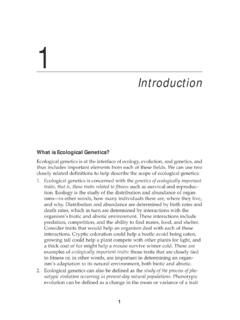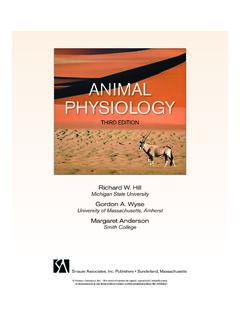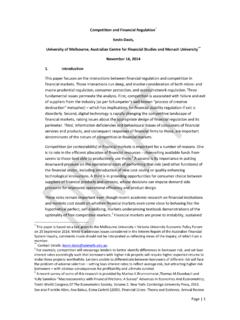Transcription of PRINCIPLES OF POPULATION GENETICS - sinauer.com
1 Daniel L. Hartl & andrew G. ClarkPRINCIPLES OF POPULATIONGENETICSFOURTH EDITIOND aniel L. HartlHarvard UniversityAndrew G. ClarkCornell UniversitySinauer Associates, Inc. PublishersSunderland, MassachusettsH-C 4E FM 12/4/06 11:56 AM Page iii Sinauer Associates, Inc. This material cannot be copied, reproduced, manufactured or disseminated in any form without express written permission from the RELEVANCE PHENOTYPICVARIATION INNATURALPOPULATIONS5 Continuous Variation: The Normal Distribution 5 Mean and Variance 6 The Central Limit Theorem 8 Discrete Mendelian Variation MAINTENANCE MOLECULARPOPULATIONGENETICS15 Electrophoresis 16 Allele Frequencies and Genotype Frequencies 18 Polymorphism and Heterozygosity 20 Allozyme Polymorphisms 21 Inferences from Allozyme Polymorphisms POLYMORPHISMS INDNA SEQUENCES25 Restriction Enzymes 25 The Polymerase Chain Reaction 28 Single Nucleotide Polymorphisms 32 Synonymous and Nonsynonymous Polymorphisms 32 Segregating Sites and Nucleotide Mismatches UTILITY OFGENETICPOLYMORPHISMS38 PREFACExii1 genetic ANDPHENOTYPICVARIATION3H-C 4E FM 12/4/06 11:56 AM Page vi Sinauer Associates, Inc.
2 This material cannot be copied, reproduced, manufactured or disseminated in any form without express written permission from the MUTATION151 Irreversible Mutation 152 Reversible Mutation MUTATION ANDRANDOMGENETICDRIFT158 Probability of Fixation of a New Neutral Mutation THENEUTRALTHEORY THEINFINITE-ALLELESMODEL162 The Ewens Sampling Formula 166 The Ewens-Watterson Test 168 Contentsvii2 ORGANIZATION RANDOM MATING46 Nonoverlapping Generations THEHARDY-WEINBERGPRINCIPLE48 Random Mating of Genotypes versus Random Union of Gametes 50 Implications of the Hardy-Weinberg Principle TESTING FORHARDY-WEINBERGEQUILIBRIUM54 Difficulties in Testing for Hardy-Weinberg Equilibrium 54 Complications of Dominance 62 Frequency of Heterozygotes EXTENSIONS OF THEHARDY-WEINBERGPRINCIPLE67 Three or More Alleles
3 67X-Linked Genes LINKAGE ANDLINKAGEDISEQUILIBRIUM73 Difficulties in Testing for Linkage Equilibrium 82 Relative Measures of Linkage Disequilibrium: D and CAUSES OFLINKAGEDISEQUILIBRIUM84 Linkage Disequilibrium Due to POPULATION Admixture 85 Linkage Disequilibrium Due to Reduced Recombination RANDOMGENETICDRIFT THEWRIGHT FISHERMODEL THEDIFFUSIONAPPROXIMATION105An Approach Looking Forward 106An Approach Looking Backward 110 Absorption Time and Time to Fixation RANDOMDRIFT IN EFFECTIVEPOPULATIONSIZE121 Fluctuation in POPULATION Size 121 Unequal Sex Ratio, Sex Chromosomes, Organelle Genes 123 Variance in Offspring Number 126 Effective Size of a Subdivided POPULATION GENETREES ANDCOALESCENCE128 Coalescent Effective Size 133 Coalescence with POPULATION Growth 134 Coalescent Models with Mutation 136 Applications of Coalescent Methods THEORETICALIMPLICATIONS OFCOALESCENCE138 Coalescent Models with Recombination 140 Linkage Disequilibrium Mapping 1434 MUTATION AND THENEUTRALTHEORY151H-C 4E FM 12/4/06 11:56 AM Page vii Sinauer Associates, Inc.
4 This material cannot be copied, reproduced, manufactured or disseminated in any form without express written permission from the INFINITE-SITESMODEL172 Nucleotide Polymorphism and Nucleotide Diversity 175 Tajima s DStatistic 176 The Fu and Li Test of Fit to Neutral Coalescence MUTATION ANDRECOMBINATION182A Model for the Evolutionary Benefit of Recombination 183 Muller s Ratchet 185 Piecewise Recombination in Bacteria 187 Animal Mitochondrial DNA SELECTION INHAPLOIDORGANISMS200 Discrete Generations 200 Continuous Time 204 Change in Allele Frequency in Haploids 205 Darwinian Fitness and Malthusian Fitness SELECTION INDIPLOIDORGANISMS206 Change in Allele Frequency in Diploids 208 Marginal Fitness and Selection with Multiple Alleles 212 Application to the Evolution of Insecticide Resistance
5 EQUILIBRIA WITHSELECTION215 Overdominance 216 Local Stability 220 Heterozygote Inferiority 222 Stable Equilibria with Multiple Alleles 223 Adaptive Topography and the Role of Random genetic Drift MUTATION-SELECTIONBALANCE226 Equilibrium Allele Frequencies 226 The Haldane-Muller Principle MORECOMPLEXTYPES OFSELECTION229 Differential Selection in the Sexes 229X-Linked Genes 230 Frequency-Dependent Selection 230 Density-Dependent Selection 231 Fecundity Selection 231 Age-Structured Populations 232 Heterogenous Environments and Clines 232 Diversifying Selection 234 Gametic Selection 236 Meiotic Drive 236 Multiple Loci and Gene Interaction: Epistasis 239 Evolution of Recombination Rate 241 Sexual Selection 241 Kin Selection INTERDEMESELECTION SELECTION IN AFINITEPOPULATION248 Weak Selection and the Nearly Neutral Theory 248 genetic Draft 2516 INBREEDING, POPULATIONSUBDIVISION, INBREEDING257 The Inbreeding Coefficient 258 Genotype Frequencies with Inbreeding 259 genetic Effects of Inbreeding 265 Calculation of the Inbreeding Coefficient from Pedigrees 268 Regular Systems of Mating POPULATIONSUBDIVISION275 Reduction in Heterozygosity Due to POPULATION Subdivision 276 Average Heterozygosity 278 Wright s FStatistics 281 Linanthus Revisited: Evidence for Selection Associated with Flower Color 285H-C 4E FM 12/4/06 11:56 AM Page viii Sinauer Associates, Inc.
6 This material cannot be copied, reproduced, manufactured or disseminated in any form without express written permission from the of POPULATION Structure from Multilocus Genotype Data THEWAHLUNDPRINCIPLE288 Wahlund s Principle and the Fixation Index 291 Genotype Frequencies in Subdivided Populations 291 Relation between the Inbreeding Coefficientand the FStatistics MIGRATION295 One-Way Migration 295 The Island Model of Migration 297 How Migration Limits genetic Divergence 299 Estimates of Migration Rates 303 Coalescence-Based Estimates of Migration 303 Migration-Selection Balance THENEUTRALTHEORY ANDMOLECULAREVOLUTION318 Theoretical PRINCIPLES of the Neutral Theory ESTIMATINGRATES OFMOLECULARSEQUENCEDIVERGENCE321 Rates of Amino Acid Replacement 322 Rates of Nucleotide Substitution 326
7 Statistical Fitting of Nucleotide Substitution Models THEMOLECULARCLOCK329 Variation among Genes in the Rate of the Molecular Clock 332 Variation across Lineages in Clock Rate 334 The Generation-Time Effect 337 The Overdispersed Molecular Clock and the Neutral Theory 338 The Nearly Neutral Theory PATTERNS OFNUCLEOTIDE ANDAMINOACIDSUBSTITUTION340 Calculating Synonymous and Non-synonymous Substitution Rates 340 Codon Substitution Models 343 Observations of Synonymous and Nonsynonymous Substitution Rates 345 Polymorphism within Species 347 Implications of Codon Usage Bias POLYMORPHISM ANDDIVERGENCEINNUCLEOTIDESEQUENCE THEMCDONALD-KREITMAN ANDHKA TESTS351 Polymorphism and Divergence in Noncoding Sequences 354 Impact of Local Recombination Rates 354 Substitution Models for Structural RNA Genes GENEGENEALOGIES358 Hypothesis Testing Using Trees MITOCHONDRIAL ANDCHLOROPLASTDNA EVOLUTION362 Chloroplast DNA and Organelle Transmission in Plants 363 Maintenance of Variation in Organelle Genomes 364 Evidence for Selection in mtDNA MOLECULARPHYLOGENETICS366 Algorithms for Phylogenetic Tree Reconstruction 366 Distance Methods versus Parsimony 369 Bootstrapping and Statistical Confidence in a Tree 370 Bayesian Methods 370 Trans-Species Polymorphism MULTIGENEFAMILIES372 Concerted Evolution 374 Subfunctionalization 375 Birth-and-Death Process 376H-C 4E FM 12/4/06 11:56 AM Page ix Sinauer Associates, Inc.
8 This material cannot be copied, reproduced, manufactured or disseminated in any form without express written permission from the TYPES RESEMBLANCE BETWEENRELATIVES ANDTHECONCEPT ARTIFICIALSELECTION ANDREALIZEDHERITABILITY394 Contribution of New Mutations to the Response to Selection 396 Prediction Equation for Individual Selection 397 Limits to Selection GENETICMODELS FORQUANTITATIVETRAITS403 Change in Allele Frequency 412 Change in Mean Phenotype 413 Linearity of Response COMPONENTS OFPHENOTYPICVARIANCE416 genetic and Environmental Sources of Variation 416 Components of Genotypic Variation COVARIANCE AMONGRELATIVES426 Twin Studies and Inferences of Heritability in Humans 430 Estimation of genetic Variance Components in Natural Populations NORM OFREACTION, THRESHOLDTRAITS.
9 ANDGENETICCORRELATION433 Norm of Reaction and Phenotypic Plasticity 433 Threshold Traits: Genes as Risk Factors in Disease 437 genetic Correlation and Correlated Response EVOLUTIONARYQUANTITATIVEGENETICS443 Inference of Selection from Phenotypic Data 443 Evolution of Multiple Intercorrelated Traits 444 Random genetic Drift and Phenotypic Evolution 446 Mutational Variance and Mutation-Accumulation Experiments 448 Mutation-Selection Balance for Quantitative Traits GENES THATAFFECTQUANTITATIVETRAITS452 The Number of Genes Affecting Quantitative Traits 453 Methods for Mapping QTLs EVOLUTION OFGENOMESIZEANDCOMPOSITION470 Organismic Complexity and the C-Value Paradox 470 Base Composition of Genomic DNA GENOME-WIDEPATTERNS OFPOLYMORPHISM473 Excess Polymorphism in Subtelomeric Regions 473 Polymorphism and Rates of Recombination 475 Hitchhiking versus
10 Background Selection 477 Linkage Disequilibrium and Haplotype Structures 481 Decline of Linkage Disequilibrium with genetic Distance DIFFERENCES BETWEENSPECIES484 Comparison of Nonsynonymous and Synonymous Divergence 484 Positive Selection 486 Exploiting a Phylogenetic Signal 487 Polymorphism and Divergence 487 Compensated Pathogenic Deviations 489 Structure-Function Analysis SEXUALSELECTION AND THESEXCHROMOSOMES492 Faster-Male Molecular Evolution 493H-C 4E FM 12/4/06 11:56 AM Page x Sinauer Associates, Inc. This material cannot be copied, reproduced, manufactured or disseminated in any form without express written permission from the Evolution of Genes in the X Chromosome 495 Haldane s Rule 495 Demasculinization of the X Chromosome TRANSPOSABLEELEMENTS498 Diverse Types of Transposable Elements 498 Factors Controlling the POPULATION Dynamics of Transposable Elements 501 Insertion Sequences and Composite Transposons in Bacteria 502 Transposable Elements in Eukaryotes 505 POPULATION Dynamics of Transposable Elements 505 Nonuniformity of Transposition Rates 506 Horizontal Transmission of Transposable Elements HUMANPOLYMORPHISM520 Public SNP Resources and the HapMap Project POPULATIONGENETICINFERENCESFROMHUMANSNPS 524 Ascertainment Bias of SNP Genotypes 524 Departures from Hardy-Weinberg Frequencies 527












